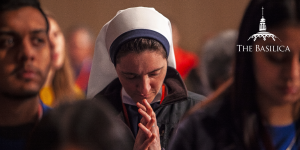
As the faithful prepare to celebrate Divine Mercy Sunday, it is important to review the meaning and historical significance of the day. On the Second Sunday of Easter of the Jubilee Year 2000, at the Mass for the Canonization of St. Faustina Kowalska, Pope John Paul II declared the Sunday after Easter be called “Divine Mercy Sunday.”
St. Faustina was a Polish nun who received visions from Jesus, including one of Jesus wearing a white garment with beams of red and white coming from His heart, which came to be known as the image of Divine Mercy. She wrote in her diary that He said:
I want the Image to be solemnly blessed on the first Sunday after Easter, and I want it to be venerated publicly so that every soul may know about it…
My daughter, tell the whole world about My inconceivable mercy. I desire that the Feast of Mercy be a refuge and shelter for all souls, and especially for poor sinners. I pour out a whole ocean of graces upon those souls who approach the fount of My mercy.
 According to the vision, those who receive communion and attend confession on the Feast of Mercy receive total forgiveness of sins.
According to the vision, those who receive communion and attend confession on the Feast of Mercy receive total forgiveness of sins.
Pope John Paul II discussed the significance of the image of Divine Mercy in his homily for the canonization of St. Faustina:
From that Heart [of Christ], Sr. Faustina Kowalska, the blessed whom from now on we will call a saint, will see two rays of light shining from that heart and illuminating the world. “The two rays”, Jesus Himself explained to her one day, “represent blood and water” (Diary, entry 299).
Blood and water! We immediately think of the testimony given by the Evangelist John, who, when a soldier on Calvary pierced Christ’s side with his spear, sees blood and water flowing from it (see Jn 19:34). Moreover, if the blood recalls the sacrifice of the Cross and the gift of the Eucharist, the water, in Johannine symbolism, represents not only Baptism but also the gift of the Holy Spirit (see Jn 3:5; 4:14; 7:37-39).
Divine Mercy Sunday focuses on the gift of mercy and love given through Christ’s death, burial, and resurrection. As Pope John Paul II stated, “Divine Mercy reaches human beings through the heart of Christ crucified.”
On Divine Mercy Sunday, the Basilica will celebrate its regularly scheduled Masses and offer an extended confession schedule from 10:00 a.m. – 6:00 p.m. Of special note, our 12 noon Solemn Mass of Divine Mercy Sunday will be celebrated by Archbishop Augustine Di Noia, O.P., Adjunct Secretary of the Congregation for the Doctrine of the Faith. A Plenary Indulgence under the usual conditions (sacramental confession, Eucharistic Communion, and offer a prayer for the intentions of the Holy Father) may be obtained by the faithful on this day.
In addition to the Basilica’s regular schedule of Masses, the Marians of the Immaculate Conception will offer Recitation of the Divine Mercy Chaplet at 2:00 p.m., with Mass to follow immediately afterward.
There will also be a special Octave of Easter Organ Recital featuring guest organist Clay Christiansen of the Salt Lake Tabernacle in the Great Upper Church at 6:00 p.m.

